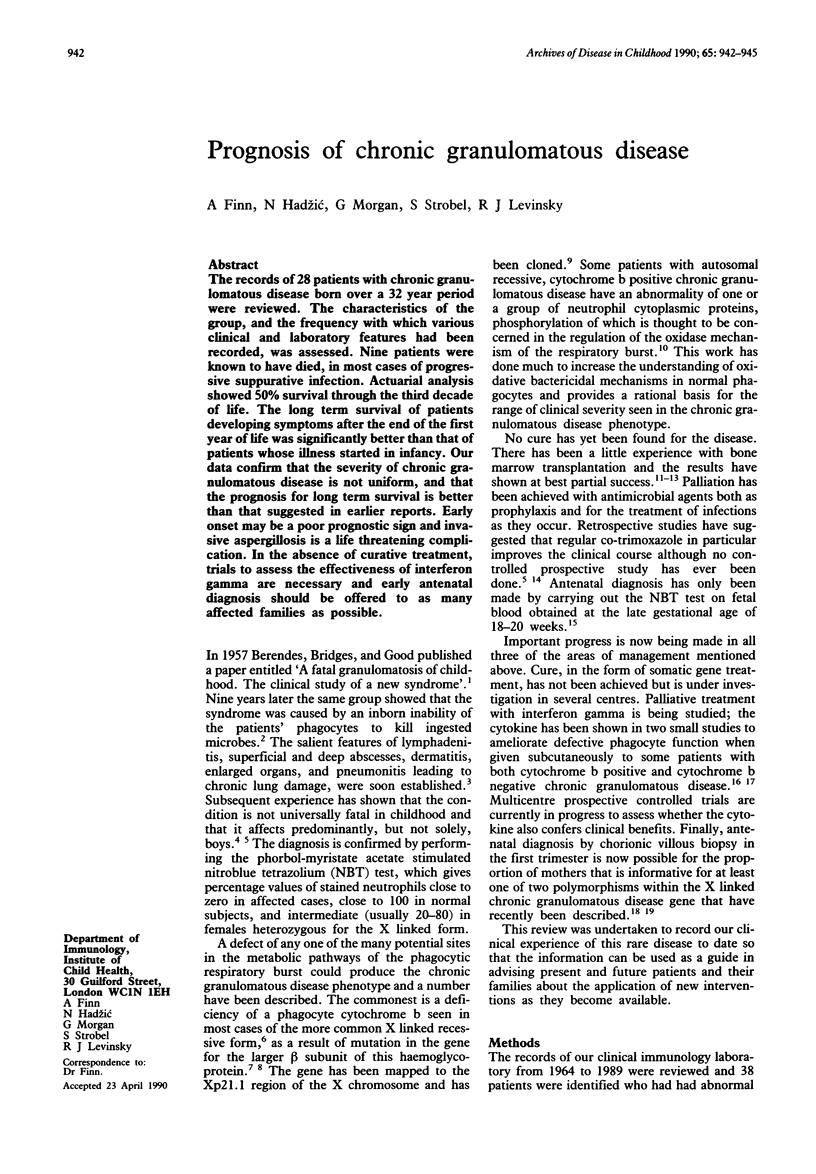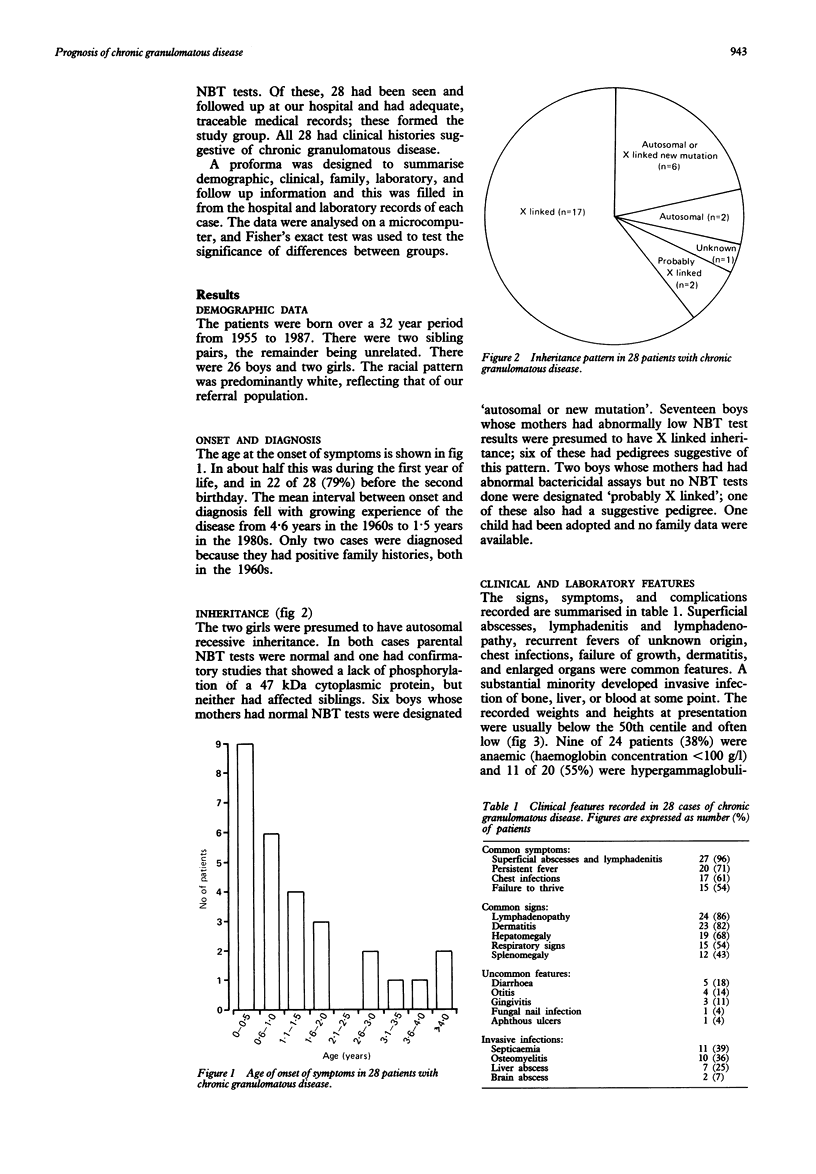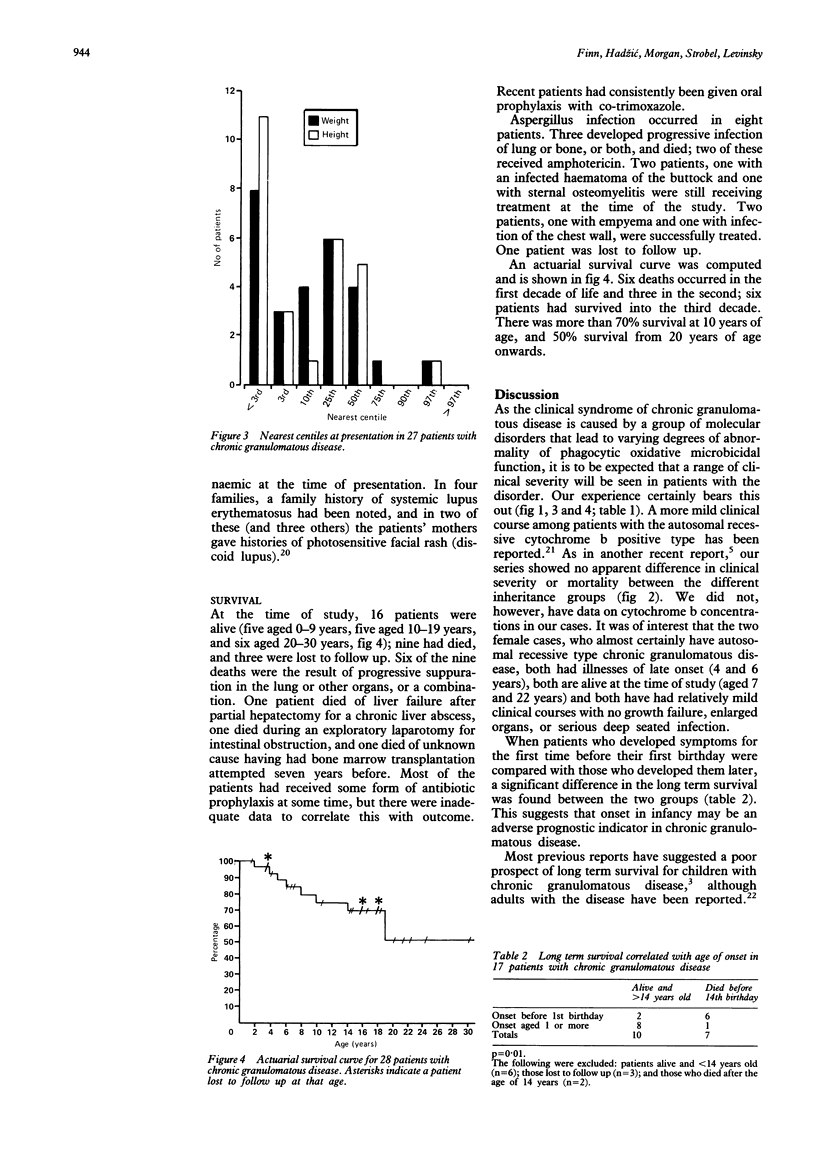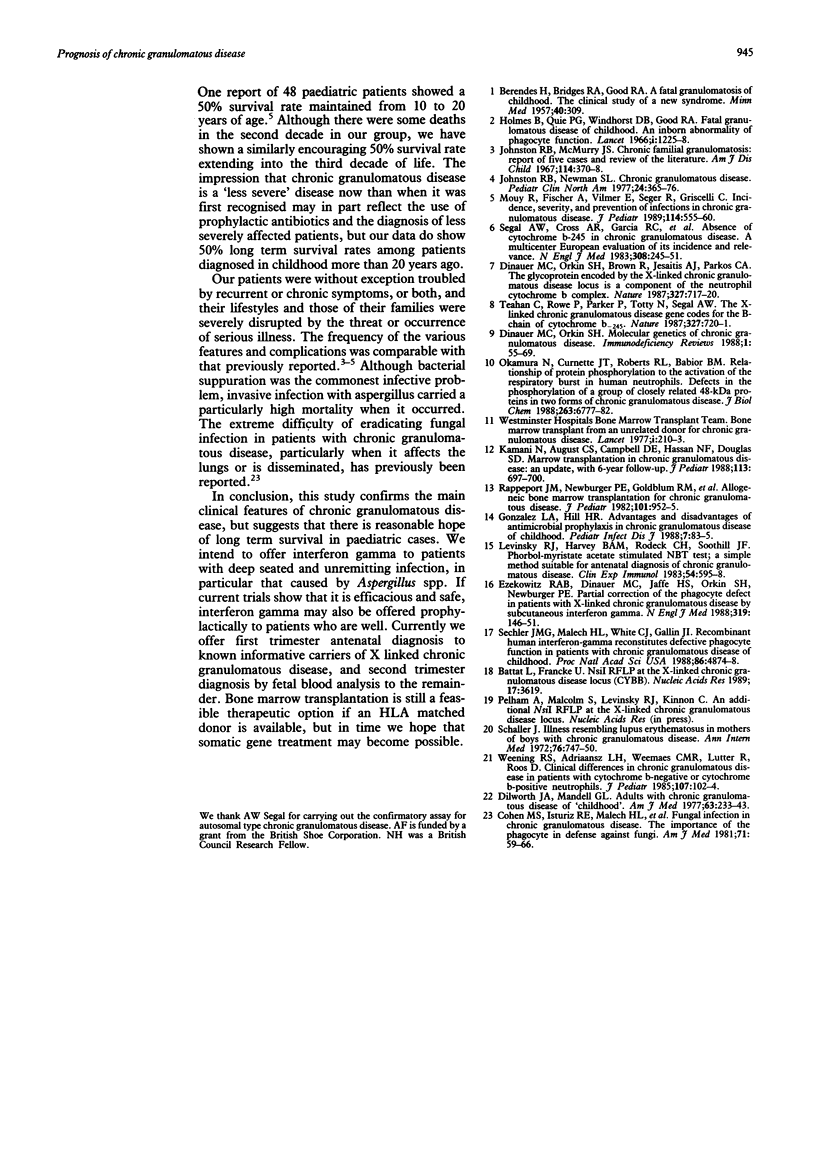Abstract
The records of 28 patients with chronic granulomatous disease born over a 32 year period were reviewed. The characteristics of the group, and the frequency with which various clinical and laboratory features had been recorded, was assessed. Nine patients were known to have died, in most cases of progressive suppurative infection. Actuarial analysis showed 50% survival through the third decade of life. The long term survival of patients developing symptoms after the end of the first year of life was significantly better than that of patients whose illness started in infancy. Our data confirm that the severity of chronic granulomatous disease is not uniform, and that the prognosis for long term survival is better than that suggested in earlier reports. Early onset may be a poor prognostic sign and invasive aspergillosis is a life threatening complication. In the absence of curative treatment, trials to assess the effectiveness of interferon gamma are necessary and early antenatal diagnosis should be offered to as many affected families as possible.
Full text
PDF



Selected References
These references are in PubMed. This may not be the complete list of references from this article.
- BERENDES H., BRIDGES R. A., GOOD R. A. A fatal granulomatosus of childhood: the clinical study of a new syndrome. Minn Med. 1957 May;40(5):309–312. [PubMed] [Google Scholar]
- Battat L., Francke U. Nsi I RFLP at the X-linked chronic granulomatous disease locus (CYBB). Nucleic Acids Res. 1989 May 11;17(9):3619–3619. doi: 10.1093/nar/17.9.3619. [DOI] [PMC free article] [PubMed] [Google Scholar]
- Cohen M. S., Isturiz R. E., Malech H. L., Root R. K., Wilfert C. M., Gutman L., Buckley R. H. Fungal infection in chronic granulomatous disease. The importance of the phagocyte in defense against fungi. Am J Med. 1981 Jul;71(1):59–66. doi: 10.1016/0002-9343(81)90259-x. [DOI] [PubMed] [Google Scholar]
- Dilworth J. A., Mandell G. L. Adults with chronic granulomatous disease of "childhood". Am J Med. 1977 Aug;63(2):233–243. doi: 10.1016/0002-9343(77)90237-6. [DOI] [PubMed] [Google Scholar]
- Dinauer M. C., Orkin S. H., Brown R., Jesaitis A. J., Parkos C. A. The glycoprotein encoded by the X-linked chronic granulomatous disease locus is a component of the neutrophil cytochrome b complex. 1987 Jun 25-Jul 1Nature. 327(6124):717–720. doi: 10.1038/327717a0. [DOI] [PubMed] [Google Scholar]
- Dinauer M. C., Orkin S. H. Molecular genetics of chronic granulomatous disease. Immunodefic Rev. 1988;1(1):55–69. [PubMed] [Google Scholar]
- Ezekowitz R. A., Dinauer M. C., Jaffe H. S., Orkin S. H., Newburger P. E. Partial correction of the phagocyte defect in patients with X-linked chronic granulomatous disease by subcutaneous interferon gamma. N Engl J Med. 1988 Jul 21;319(3):146–151. doi: 10.1056/NEJM198807213190305. [DOI] [PubMed] [Google Scholar]
- Gonzalez L. A., Hill H. R. Advantages and disadvantages of antimicrobial prophylaxis in chronic granulomatous disease of childhood. Pediatr Infect Dis J. 1988 Feb;7(2):83–85. [PubMed] [Google Scholar]
- Holmes B., Quie P. G., Windhorst D. B., Good R. A. Fatal granulomatous disease of childhood. An inborn abnormality of phagocytic function. Lancet. 1966 Jun 4;1(7449):1225–1228. doi: 10.1016/s0140-6736(66)90238-8. [DOI] [PubMed] [Google Scholar]
- Johnston R. B., Jr, McMurry J. S. Chronic familial granulomatosis. Report of five cases and review of the literature. Am J Dis Child. 1967 Oct;114(4):370–378. doi: 10.1001/archpedi.1967.02090250068002. [DOI] [PubMed] [Google Scholar]
- Johnston R. B., Newman S. L. Chronic granulomatous disease. Pediatr Clin North Am. 1977 May;24(2):365–376. doi: 10.1016/s0031-3955(16)33424-1. [DOI] [PubMed] [Google Scholar]
- Kamani N., August C. S., Campbell D. E., Hassan N. F., Douglas S. D. Marrow transplantation in chronic granulomatous disease: an update, with 6-year follow-up. J Pediatr. 1988 Oct;113(4):697–700. doi: 10.1016/s0022-3476(88)80382-2. [DOI] [PubMed] [Google Scholar]
- Levinsky R. J., Harvey B. A., Rodeck C. H., Soothill J. F. Phorbol myristate acetate stimulated NBT test: a simple method suitable for antenatal diagnosis of chronic granulomatous disease. Clin Exp Immunol. 1983 Nov;54(2):595–598. [PMC free article] [PubMed] [Google Scholar]
- Mouy R., Fischer A., Vilmer E., Seger R., Griscelli C. Incidence, severity, and prevention of infections in chronic granulomatous disease. J Pediatr. 1989 Apr;114(4 Pt 1):555–560. doi: 10.1016/s0022-3476(89)80693-6. [DOI] [PubMed] [Google Scholar]
- Okamura N., Curnutte J. T., Roberts R. L., Babior B. M. Relationship of protein phosphorylation to the activation of the respiratory burst in human neutrophils. Defects in the phosphorylation of a group of closely related 48-kDa proteins in two forms of chronic granulomatous disease. J Biol Chem. 1988 May 15;263(14):6777–6782. [PubMed] [Google Scholar]
- Rappeport J. M., Newburger P. E., Goldblum R. M., Goldman A. S., Nathan D. G., Parkman R. Allogeneic bone marrow transplantation for chronic granulomatous disease. J Pediatr. 1982 Dec;101(6):952–955. doi: 10.1016/s0022-3476(82)80017-6. [DOI] [PubMed] [Google Scholar]
- Schaller J. Illness resembling lupus erythematosus in mothers of boys with chronic granulomatous disease. Ann Intern Med. 1972 May;76(5):747–750. doi: 10.7326/0003-4819-76-5-747. [DOI] [PubMed] [Google Scholar]
- Sechler J. M., Malech H. L., White C. J., Gallin J. I. Recombinant human interferon-gamma reconstitutes defective phagocyte function in patients with chronic granulomatous disease of childhood. Proc Natl Acad Sci U S A. 1988 Jul;85(13):4874–4878. doi: 10.1073/pnas.85.13.4874. [DOI] [PMC free article] [PubMed] [Google Scholar]
- Segal A. W., Cross A. R., Garcia R. C., Borregaard N., Valerius N. H., Soothill J. F., Jones O. T. Absence of cytochrome b-245 in chronic granulomatous disease. A multicenter European evaluation of its incidence and relevance. N Engl J Med. 1983 Feb 3;308(5):245–251. doi: 10.1056/NEJM198302033080503. [DOI] [PubMed] [Google Scholar]
- Teahan C., Rowe P., Parker P., Totty N., Segal A. W. The X-linked chronic granulomatous disease gene codes for the beta-chain of cytochrome b-245. 1987 Jun 25-Jul 1Nature. 327(6124):720–721. doi: 10.1038/327720a0. [DOI] [PubMed] [Google Scholar]
- Weening R. S., Adriaansz L. H., Weemaes C. M., Lutter R., Roos D. Clinical differences in chronic granulomatous disease in patients with cytochrome b-negative or cytochrome b-positive neutrophils. J Pediatr. 1985 Jul;107(1):102–104. doi: 10.1016/s0022-3476(85)80626-0. [DOI] [PubMed] [Google Scholar]


